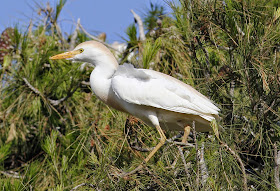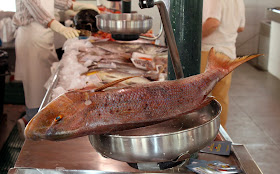Wednesday began with yet more strong wind and showery spells from the north, hardly the best weather for finding later migrants arriving for the British Summer. Looks like I will have to invest in a pair of Stanfield's Canadian Thermal Long Johns for our UK summers.
So I took a day off birding until Thursday on the strength of a better forecast and set about creating a blog post about the recent Menorca holiday.
So I took a day off birding until Thursday on the strength of a better forecast and set about creating a blog post about the recent Menorca holiday.
There’s a well-worn route of ours via the ME1 and the Ronda which circumvents Ciutadella to reach Punta Nati, a rather desolate and sometimes windswept point at the north west corner of Menorca. Punta Nati is the place to see Ravens, larks, pipits, large numbers of Corn Buntings and when conditions are right, a number of raptors and other migrant birds.
A mile before Punta Nati there’s a colony of Cattle Egrets in a pine plantation at the roadside. But the tiny stopping place leaves the car vulnerable to scraping the wing mirror on a stone wall or being hit by traffic zooming into Ciutadella a mile away. So it’s a quick point and shoot where the egrets are quite amenable as long as you don’t leave the car expecting the egrets to stay put. Many a budding photographer has discovered that should they approach on foot the egrets readily erupt into a cacophony of noise and action then depart the trees.
The stone walls near the point provide lots of singing posts for Short-toed Larks, Corn Buntings, Thekla Larks and Tawny Pipits. In early May those species are well into the breeding season with much display, song and evidence of youngsters in the nest.
Short-toed Lark
The Theklas proved harder to photograph this time, the only half decent pictures obtained on the single grey morning we encountered.
The other speciality of the rocky landscape of Punta Nati is the Blue Rock Thrush, a species which like most members of the thrush family is generally shy. Here’s a somewhat distant picture of a male and female together. The Blue Rock Thrush is fairly common but not always easily seen in Menorca.
Egyptian Vultures are usually about and it was here that on our second and sunny visit I came across an adult bird taking off from a rocky field and heading south, gaining height as it did so. The usual views of Egyptian Vultures consist of birds soaring over the Menorcan landscape at great height, where their almost 6ft wingspan makes them unmistakeable, even from some distance away.
The Egyptian Vulture (Neophron percnopterus), also called the white scavenger vulture or pharaoh's chicken, is a small Old World vulture and the only member of the genus Neophron. The use of the vulture as a symbol of royalty in Egyptian culture and their protection by Pharaonic law made the species common on the streets of Egypt and gave rise to the name "pharaoh's chicken".
Egyptian Vultures feed mainly on carrion but are opportunistic and will prey on small mammals, birds, and reptiles. They also feed on the eggs of other birds, breaking larger ones by tossing a large pebble onto them. The use of tools is rare in birds and apart from the use of a pebble as a hammer, Egyptian Vultures also use twigs to roll up wool for use in their nest. Populations of this species have declined in the 20th century and some isolated island populations e.g The Canary Islands and Menorca, are endangered by hunting, accidental poisoning, and collision with power lines.
On our sunny visit to Punta Nati we clocked up Kestrel, Red Kite, Booted Eagle, Peregrine plus a good number of Whinchats and Wheatears. We didn’t see the Stone Curlew here this year which does occur around Punta Nati, but a shy species which is not easily spotted amongst the grey rocky landscape. However we did manage to see two at Tirant on another day and another story.
It’s the trade-off for a morning’s birding at Punta Nati, a stop off in Cutadella, Menorca’s second but far from second-rate city. Here are a few pictures which give a flavour of this most picturesque, historic, vibrant and wonderfully authentic Spanish city.
The cathedral Ciutadella
Cafe Culture - Menorca
The fish market - Ciutadella
Market Square - Ciutadella
Photography Exhibition - Ciutadella
The Harbour - Ciutadella
Placa Des Born - Ciutadella
Another Coffee Stop - Ciutadella
We called into one of our favourite shops where the Jamóns are displayed along the shelves and where Menorcan quesos lie slowly maturing. Jamón ibérico or "Iberian ham", also called pata negra is a type of cured ham produced in Spain. Meanwhile the Menorcan countryside is dotted with farms which sell home-made speciality cheeses. The aromas created by these and other delicacies in delicatessens are simply heavenly making it impossible to leave such a shop without indulging in one or two samples.
More from home and away soon on Another Bird Blog.























loved the bird varieties you shared. that blue thrush is a new one for me!
ReplyDeleteI hope you realize, Exalted Philmeister, that you are making us all green with envy. I would love to buy a fresh, crusty bread and get a few slices of ham and cheese, perhaps a few olives too and I'd have a perfect lunch. Then if an Egyptian Vulture or two flew overhead and dipped its wings in greeting, the repast would be complete.
ReplyDeletePhil, I love all your bird photos, as always, and what a treat to see the extra photos of coffee shops, etc. I always love to see restaurants and shops in other parts of the world. Thank you so much for sharing.
ReplyDeleteI could just watch those vultures forever - what beautiful soaring shots!
ReplyDeleteI agree with David above, I think you have made us green with envy. Beautiful birds, great food and gorgeous scenery!
ReplyDeleteThanks for sharing, I hope your weather is better for your next outing.
I think PHil, I also agree with both Eileen and David above, that sounds grat to me. You managed to see and photograph a good variety of birds and it was lovely to see the scenes from where you were.
ReplyDeleteLovely photos of the birds and it was great to see some photos of the surroundings as well.
ReplyDelete